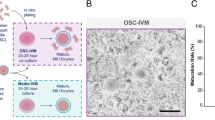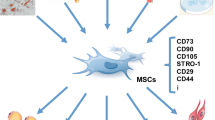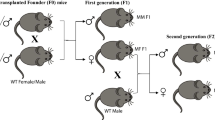Abstract
The caprine mesenchymal stem cells (MSCs) derived from fetal adnexa are highly proliferative. These cells possess tri-lineage differentiation potential and express MSC surface antigens and pluripotency markers with a wound-healing potential. This present study was conducted to compare the immunomodulatory potential of caprine MSCs derived from the fetal adnexa. Mid-gestation caprine uteri (2–3 months) were collected from the abattoir to isolate MSCs from amniotic fluid (cAF), amniotic sac (cAS), Wharton’s jelly (cWJ) and cord blood (cCB), which were expanded and characterized at the 3rd passage. These MSCs were then stimulated with inflammatory cytokines (IFN-γ and TNF-α) to assess the percentage of inhibition produced on peripheral blood mononuclear cells (PBMCs) proliferation. The percentage of inhibition on activated PBMCs proliferation produced by cWJ MSCs and cAS MSCs was significantly higher than cCB and cAF MSCs. The relative mRNA expression profile and immunofluorescent localization of different immunomodulatory cytokines and growth factors were conducted upon stimulation. The mRNA expression profile of a set of different cytokines and growth factors in each caprine fetal adnexa MSCs were modulated. Indoleamine 2, 3 dioxygenase appeared to be the major immunomodulator in cWJ, cAF, and cCB MSCs whereas inducible nitric oxide synthase in cAS MSCs. This study suggests that caprine MSCs derived from fetal adnexa display variable immunomodulatory potential, which appears to be modulated by different molecules among sources.





Similar content being viewed by others
References
Barboni B, Russo V, Berardinelli P, Mauro A, Valbonetti L, Sanyal H, Canciello A, Greco L, Muttini A, Gatta V, Stuppia L (2018) Placental stem cells from domestic animals: translational potential and clinical relevance. Cell Transplant 27(1):93–116
Ilic D, Polak JM (2011) Stem cells in regenerative medicine: introduction. Br Med Bull 98(1):117–126
Cremonesi F, Corradetti B, Consiglio AL (2011) Fetal adnexa derived stem cells from domestic animal: progress and perspectives. Theriogenology 75(8):1400–1415
Iacono E, Rossi B, Merlo B (2015) Stem cells from foetal adnexa and fluid in domestic animals: an update on their features and clinical application. Reprod Domest Anim 50(3):353–364
Pratheesh MD, Dubey PK, Gade NE, Nath A, Sivanarayanan TB, Madhu DN, Somal A, Baiju I, Sreekumar TR, Gleeja VL, Bhatt IA (2017) Comparative study on characterization and wound healing potential of goat (Capra hircus) mesenchymal stem cells derived from fetal origin amniotic fluid and adult bone marrow. Res Vet Sci 112:81–88
Somal A, Bhat IA, Singh AP, Panda BS, Desingu PA, Pandey S, Bharti MK, Pal A, Saikumar G, Chandra V, Sharma GT (2017) Impact of cryopreservation on caprine fetal adnexa derived stem cells and its evaluation for growth kinetics, phenotypic characterization, and wound healing potential in xenogenic rat model. J Cell Physiol 232(8):2186–2200
Somal A, Bhat IA, Pandey S, Panda BS, Thakur N, Sarkar M, Chandra V, Saikumar G, Sharma GT (2016) A comparative study of growth kinetics, in vitro differentiation potential and molecular characterization of fetal adnexa derived caprine mesenchymal stem cells. PLoS ONE 11(6):e0156821
da Silva ML, Fontes AM, Covas DT, Caplan AI (2009) Mechanisms involved in the therapeutic properties of mesenchymal stem cells. Cytokine Growth Factor Rev 20(5–6):419–427
Pieri NC, de Souza AF, Botigelli RC, Machado LS, Ambrosio CE, dos Santos MD, de Andrade AF, Meirelles FV, Hyttel P, Bressan FF (2019) Stem cells on regenerative and reproductive science in domestic animals. Vet Res Commun 43(1):7–16
Sasaki M, Abe R, Fujita Y, Ando S, Inokuma D, Shimizu H (2008) Mesenchymal stem cells are recruited into wounded skin and contribute to wound repair by transdifferentiation into multiple skin cell type. J Immunol 180(4):2581–2587
Spaeth E, Klopp A, Dembinski J, Andreeff M, Marini F (2008) Inflammation and tumor microenvironments: defining the migratory itinerary of mesenchymal stem cells. Gene Ther 15(10):730–738
Kidd S, Spaeth E, Dembinski JL, Dietrich M, Watson K, Klopp A, Battula VL, Weil M, Andreeff M, Marini FC (2009) Direct evidence of mesenchymal stem cell tropism for tumor and wounding microenvironments using in vivo bioluminescent imaging. Stem cells 27(10):2614–2623
Chamberlain G, Fox J, Ashton B, Middleton J (2007) Concise review: mesenchymal stem cells: their phenotype, differentiation capacity, immunological features, and potential for homing. Stem cells 11:2739–2749
DelaRosa O, Lombardo E, Beraza A, Mancheno-Corvo P, Ramirez C, Menta R, Rico L, Camarillo E, Garcia L, Abad JL, Trigueros C (2009) Requirement of IFN-γ–mediated indoleamine 2, 3-dioxygenase expression in the modulation of lymphocyte proliferation by human adipose–derived stem cells. Tissue Eng Part A 15(10):2795–2806
Beldi G, Khosravi M, Abdelgawad ME, Salomon BL, Uzan G, Haouas H, Naserian S (2020) TNFα/TNFR2 signaling pathway: an active immune checkpoint for mesenchymal stem cell immunoregulatory function. Stem Cell Research Therapy. 11(1):1–5
Haddad R, Saldanha-Araujo F (2014) Mechanisms of T-cell immunosuppression by mesenchymal stromal cells: what do we know so far? Biomed Res Int 2014:216806
Blesson S, Thiery J, Gaudin C, Stancou R, Kolb JP, Moreau JL, Theze J, Mami-Chouaib F, Chouaib S (2002) Analysis of the mechanisms of human cytotoxic T lymphocyte response inhibition by NO. Int Immunol 14(10):1169–1178
Bogdan C (2001) Nitric oxide and the immune response. Nat Immunol 10:907–916
Staykova MA, Berven LA, Cowden WB, Willenborg DO, Crouch MF (2003) Nitric oxide induces polarization of actin in encephalitogenic T cells and inhibits their in vitro transendothelial migration in a p70S6 kinase-independent manner. FASEB J 17(10):1337–1339
Yoo KH, Jang IK, Lee MW, Kim HE, Yang MS, Eom Y, Lee JE, Kim YJ, Yang SK, Jung HL, Sung KW (2009) Comparison of immunomodulatory properties of mesenchymal stem cells derived from adult human tissues. Cell Immunol 259(2):150–156
Carrade DD, Lame MW, Kent MS, Clark KC, Walker NJ, Borjesson DL (2012) Comparative analysis of the immunomodulatory properties of equine adult-derived mesenchymal stem cells. Cell medicine 1:1–2
De Schauwer C, Goossens K, Piepers S, Hoogewijs MK, Govaere JL, Smits K, Meyer E, Van Soom A, Van de Walle GR (2014) Characterization and profiling of immunomodulatory genes of equine mesenchymal stromal cells from non-invasive sources. Stem Cell Res Ther 5(1):6
Kang JW, Kang KS, Koo HC, Park JR, Choi EW, Park YH (2008) Soluble factors–mediated immunomodulatory effects of canine adipose tissue–derived mesenchymal stem cells. Stem cells and development 17(4):681–694
Lee WS, Suzuki Y, Graves SS, Iwata M, Venkataraman GM, Mielcarek M, Peterson LJ, Ikehara S, Torok-Storb B, Storb R (2011) Canine bone marrow-derived mesenchymal stromal cells suppress alloreactive lymphocyte proliferation in vitro but fail to enhance engraftment in canine bone marrow transplantation. Biol Blood Marrow Transplant 17(4):465–475
Poncelet AJ, Vercruysse J, Saliez A, Gianello P (2007) Although pig allogeneic mesenchymal stem cells are not immunogenic in vitro, intracardiac injection elicits an immune response in vivo. Transplantation 83(6):783–790
Somal A, Aggarwal A, Upadhyay RC (2015) Effect of thermal stress on expression profile of apoptosis related genes in peripheral blood mononuclear cells of transition Sahiwal cow. Iran J Vet Res 16(2):137
Norian R, Delirezh N, Azadmehr A (2015) Evaluation of proliferation and cytokines production by mitogen-stimulated bovine peripheral blood mononuclear cells. Vet Res Forum 6(4):265
Aggarwal S, Pittenger MF (2005) Human mesenchymal stem cells modulate allogeneic immune cell responses. Blood 105(4):1815–1822
Pfaffl MW (2001) A new mathematical model for relative quantification in real-time RT–PCR. Nucleic Acids Res 29(9):e45
Kim HS, Kim KH, Kim SH, Kim YS, Koo KT, Kim TI, Seol YJ, Ku Y, Rhyu IC, Chung CP, Lee YM (2010) Immunomodulatory effect of canine periodontal ligament stem cells on allogenic and xenogenic peripheral blood mononuclear cells. J Periodontal Implant Sci 40(6):265–270
Liu H, Kemeny DM, Heng BC, Ouyang HW, Melendez AJ, Cao T (2006) The immunogenicity and immunomodulatory function of osteogenic cells differentiated from mesenchymal stem cells. J Immunol 176(5):2864–2871
Moreno R, Martínez-González I, Rosal M, Farwati A, Gratacós E, Aran JM (2010) Characterization of mesenchymal stem cells isolated from the rabbit fetal liver. Stem Cells Dev 19(10):1579–1588
Cho PS, Messina DJ, Hirsh EL, Chi N, Goldman SN, Lo DP, Harris IR, Popma SH, Sachs DH, Huang CA (2008) Immunogenicity of umbilical cord tissue–derived cells. Blood J Am Soc Hematology 111(1):430–438
Mrugala D, Bony C, Neves N, Caillot L, Fabre S, Moukoko D, Jorgensen C, Noel D (2008) Phenotypic and functional characterisation of ovine mesenchymal stem cells: application to a cartilage defect model. Ann Rheum Dis 67(3):288–295
Lange-Consiglio A, Rossi D, Tassan S, Perego R, Cremonesi F, Parolini O (2013) Conditioned medium from horse amniotic membrane-derived multipotent progenitor cells: immunomodulatory activity in vitro and first clinical application in tendon and ligament injuries in vivo. Stem cells and development 22(22):3015–3024
Carrade DD, Borjesson DL (2013) Immunomodulation by mesenchymal stem cells in veterinary species. Comp Med 63(3):207–217
Caplan AI, Dennis JE (2006) Mesenchymal stem cells as trophic mediators. J cell biochem 98(5):1076–1084
Le Blanc K, Tammik L, Sundberg B, Haynesworth SE, Ringden O (2003) Mesenchymal stem cells inhibit and stimulate mixed lymphocyte cultures and mitogenic responses independently of the major histocompatibility complex. Scand J Immunol 57(1):11–20
Meisel R, Zibert A, Laryea M, Göbel U, Däubener W, Dilloo D (2004) Human bone marrow stromal cells inhibit allogeneic T-cell responses by indoleamine 2, 3-dioxygenase–mediated tryptophan degradation. Blood 103(12):4619–4621
Mellor AL, Keskin DB, Johnson T, Chandler P, Munn DH (2002) Cells expressing indoleamine 2, 3-dioxygenase inhibit T cell responses. J Immunol 168(8):3771–3776
Krampera M, Cosmi L, Angeli R, Pasini A, Liotta F, Andreini A, Santarlasci V, Mazzinghi B, Pizzolo G, Vinante F, Romagnani P (2006) Role for interferon-γ in the immunomodulatory activity of human bone marrow mesenchymal stem cells. Stem cells 24(2):386–398
Sato K, Ozaki K, Oh I, Meguro A, Hatanaka K, Nagai T, Muroi K, Ozawa K (2007) Nitric oxide plays a critical role in suppression of T-cell proliferation by mesenchymal stem cells. Blood 109(1):228–234
Bernardo ME, Fibbe WE (2013) Mesenchymal stromal cells: sensors and switchers of inflammation. Cell Stem Cell 13(4):392–402
Kyurkchiev D, Bochev I, Ivanova-Todorova E, Mourdjeva M, Oreshkova T, Belemezova K, Kyurkchiev S (2014) Secretion of immunoregulatory cytokines by mesenchymal stem cells. World J Stem Cells 6(5):552
Ma S, Xie N, Li W, Yuan B, Shi Y, Wang Y (2014) Immunobiology of mesenchymal stem cells. Cell Death Differ 21(2):216–225
Gandhi R, Anderson DE, Weiner HL (2007) Cutting edge: immature human dendritic cells express latency-associated peptide and inhibit T cell activation in a TGF-β-dependent manner. J Immunol 178(7):4017–4021
Kushwah R, Wu J, Oliver JR, Jiang G, Zhang J, Siminovitch KA, Hu J (2010) Uptake of apoptotic DC converts immature DC into tolerogenic DC that induce differentiation of Foxp3+ Treg. Eur J Immunol 40(4):1022–1035
Yoon BS, Moon JH, Jun EK, Kim J, Maeng I, Kim JS, Lee JH, Baik CS, Kim A, Cho KS, Lee JH (2010) Secretory profiles and wound healing effects of human amniotic fluid–derived mesenchymal stem cells. Stem cells and development 19(6):887–902
Mohammadpour H, Pourfathollah AA, Nikougoftar Zarif M, Hashemi SM (2016) Increasing proliferation of murine adipose tissue-derived mesenchymal stem cells by TNF-α plus IFN-γ. Immunopharmacol Immunotoxicol 38(2):68–76
Borena BM, Martens A, Broeckx SY, Meyer E, Chiers K, Duchateau L, Spaas JH (2015) Regenerative skin wound healing in mammals: state-of-the-art on growth factor and stem cell based treatments. Cell Physiol Biochem 36(1):1–23
Sadat S, Gehmert S, Song YH, Yen Y, Bai X, Gaiser S, Klein H, Alt E (2007) The cardioprotective effect of mesenchymal stem cells is mediated by IGF-I and VEGF. Biochem Biophys Res Commun 363(3):674–679
Xing L, Cui R, Peng L, Ma J, Chen X, Xie RJ, Li B (2014) Mesenchymal stem cells, not conditioned medium, contribute to kidney repair after ischemia-reperfusion injury. Stem Cell Res Ther 5(4):1–2
Kim SW, Zhang HZ, Guo L, Kim JM, Kim MH (2012) Amniotic mesenchymal stem cells enhance wound healing in diabetic NOD/SCID mice through high angiogenic and engraftment capabilities. PLoS ONE 7(10):e41105
Houchen CW, George RJ, Sturmoski MA, Cohn SM (1999) FGF enhances intestinal stem cell survival and its expression is induced after radiation injury. Am J Physiol Gastrointest Liver Physiol 276(1):249–258
Seo BF, Jung SN (2016) The immunomodulatory effects of mesenchymal stem cells in prevention or treatment of excessive scars. Stem Cells Int 2016:6937976
Acknowledgement
The authors are thankful to the Director, ICAR-Indian Veterinary Research Institute, Izatnagar, for providing necessary facilities for conducting this work.
Funding
This study was supported by ICAR-IVRI through the Flagship Project entitled ‘Stem cells: its biology and therapeutic application in livestock and pets’. The funders had no role in study design.
Author information
Authors and Affiliations
Contributions
Conceived and designed the experiments: G Taru Sharma and Vikash Chandra. Performed the experiments: Anjali Somal, Irfan A. bhat, Mukesh Kumar Bharti, Bibhudatta S. K. Panda. Analyzed the data: Anjali Somal, Sriti Pandey and Irfan A. bhat. Mohd Matin Ansari Contributed reagents/materials/analysis tools: G Taru Sharma, Vikash Chandra and G Saikumar. Wrote the paper: Anjali Somal, Mukesh Kumar Bharti, Sriti Pandey, B. Indu, Irfan A. bhat, G Taru Sharma.
Corresponding author
Ethics declarations
Conflict of interest
The authors declare that they have no conflict of interest.
Additional information
Publisher's Note
Springer Nature remains neutral with regard to jurisdictional claims in published maps and institutional affiliations.
Supplementary Information
Below is the link to the electronic supplementary material.
Rights and permissions
About this article
Cite this article
Somal, A., Bhat, I.A., Pandey, S. et al. Comparative analysis of the immunomodulatory potential of caprine fetal adnexa derived mesenchymal stem cells. Mol Biol Rep 48, 3913–3923 (2021). https://doi.org/10.1007/s11033-021-06383-0
Received:
Accepted:
Published:
Issue Date:
DOI: https://doi.org/10.1007/s11033-021-06383-0




